February 17, 2004
Today's web log was written by Stace Beaulieu, biology research specialist at Woods Hole Oceanographic Institution.
So what’s it like to be a biologist out on a cruise with a bunch of geologists and geochemists? That’s a great question to ask me, Rhian, Cara, and Antoine. We are here to work on research projects that cross three traditional disciplines of science - biology, chemistry, and geology. Rhian and I are “macro-“ biologists, specializing in deep-sea invertebrate fauna, while Cara and Antoine are microbiologists.
Cara, a graduate student at WHOI, is studying the microbes that inhabit basalt glass, contributing to the weathering of the basalt off-axis. Antoine, a graduate student at Portland State, is identifying the microbial extremophiles that live in sulfide chimneys at the hydrothermal vents. Both Cara and Antoine have been busy in the lab, grinding rock samples prior to extracting DNA.
Rhian (about to defend her thesis at Southampton Oceanography Centre) and I (Research Specialist in Biology at WHOI) have been helping to identify animals in the Alvin dive videos and tow cam images. We also collect specimens attached to the off-axis rock samples. On today’s dive, Pilot Gavin Eppard captured a soft coral especially for Rhian, whose thesis is about deep-sea corals.
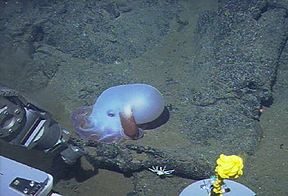

During one of the dives earlier this week, Pilot Bruce Strickrott waved at this inquisitive “Dumbo” octopus. Nearby, a crab is clinging to a tiny lava overhang. Another "Dumbo" octopus was photographed during a camera tow.
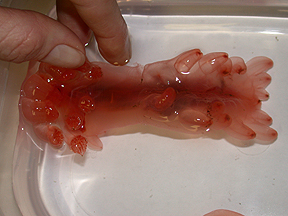
Pilot Tony Tarantino, showing his dexterity with the Alvin manipulator, captured this sea cucumber and placed it in the biobox. We will send it to the Smithsonian Institution for identification.
Yesterday’s dive, however, was the crux of the cruise for me and Rhian. The main reason why we are here on this cruise is for a project with WHOI Biologists Tim Shank and Stefan Sievert. We were funded by WHOI’s Deep Ocean Exploration Institute to conduct a pilot study of chemical and microbial settlement cues for vent-endemic invertebrates (such as tubeworms). Yesterday, we recovered six of the basalt settlement panels that had been deployed at Tica Vent in conjunction with Bill’s time-series chemical sensor. Three of the panels were out for 9 days, the other three for 13 days.
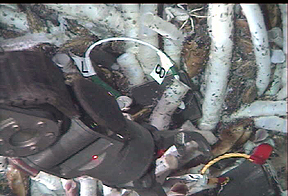
During yesterday’s dive, PIT Gavin Eppard skillfully collected six of our basalt settlement panels from Tica Vent. Here, you can see two of the panels surrounded by tubeworms and mussels.
One of the main objectives of our research was to examine microbial biofilms that develop on basalt exposed to hydrothermal fluids for several days. We also were looking for invertebrates that had settled onto the panels in the previous 9-13 days. Because this is a very limited amount of time for a new colonist to grow, we needed to examine the panels carefully under a dissecting microscope. Thus, for about nine hours after Alvin returned from the dive, we labored at the scope. While many scientists and crew were deep asleep, we were sequestered in the bio lab, forceps at hand. Needless to say, it can be difficult to take photos through a microscope on a rocking ship, and even harder when the bow-thrusters are on during the nightly cam tow. The following five photos were taken through a Leica dissecting microscope at magnifications ranging from 80X to 200X.
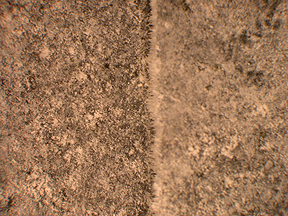
This photo shows “fuzzy bio-scum” on the basalt panel surfaces. You can see the filaments best at the intersection of the two blocks that are joined to create the panel (middle of the photo). Some limpet (feeding?) tracks are visible in the upper right.
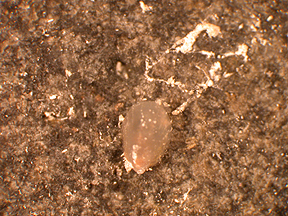
This tiny limpet (length ~1 mm) was still alive when I examined the panel, and I had to pry it from the basalt surface.
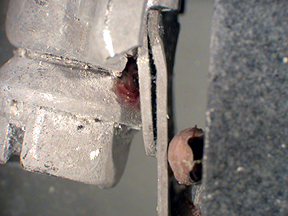
The basalt blocks for our panels were held together with a hose clamp. Here is a close-up of the animals that preferred the protection of the hose clamp to the exposure of life out on the panel surface. Under the bolt, you can see the red tentacles of a polychaete worm (Paralvinella sp.), and still attached to the basalt you can see a small snail.

Most of the invertebrate fauna that colonized the panels were found in small pores in the basalt surface. Here, in a pore about 0.5-mm across, you can see the tentacles of a tube-dwelling polychaete worm.
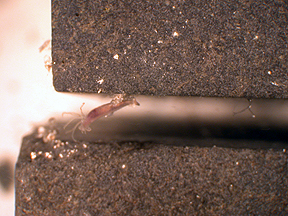
This polychaete worm (length ~1.5 mm) had secreted a tube in the crack between two blocks of basalt (I carefully removed some of the tube to show the body in this photo).
So what’s it like to be a biologist out on a cruise with a bunch of geologists and geochemists? First of all -- a great learning experience. For example, I now know the difference between lobate and pillow lavas, and folded vs. ropy sheet flows! Now, I even (kind of) know how to interpret a side-scan sonar image. Second -- really rewarding. Rhian and I really enjoy sharing our knowledge of deep-sea biology with the geologists (yes, there are colorful creatures in those cam tow images!). Third -- entertaining. I especially liked watching Kang getting disgusted by the polychaete worms that had slithered into his chemical sensor.
We thank the WHOI geologists and the University of Minnesota geochemists, especially Dan, Hans, Maurice and Bill, for allowing us the precious dive time to conduct our research, and we look forward to continued collaboration in the future.
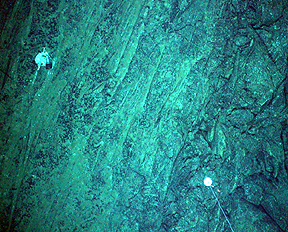
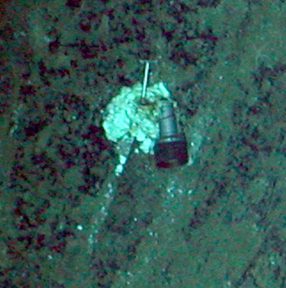
The February 16th camera tow photographed a 'foreign object' while deploying a rock core ball (left) about 400 m east of the axial trough near 9° 50'N. The object is a DeepSea Power & Light 400 watt HMI light-head that fell out of Alvin's basket during a recovery 4 years ago. Thanks to the "Rabbit Cam" the Alvin crew now knows the position of the equipment and will try to recover it during one of the upcoming dives in the EPR 9° 50'N area this spring.
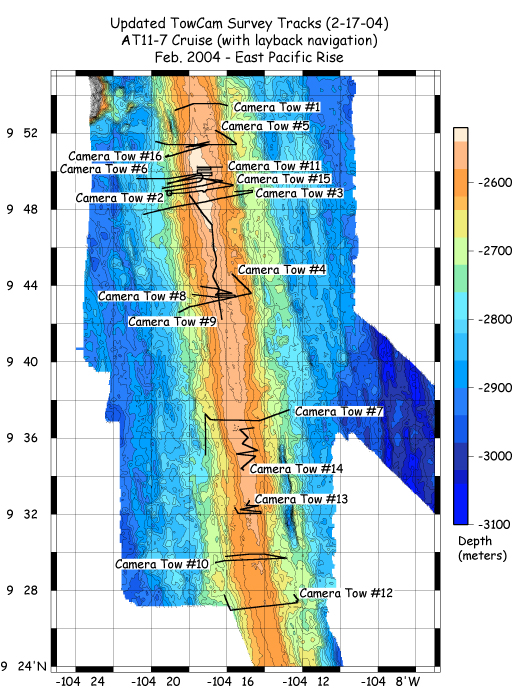
An updated map showing the locations of the 16 Camera Tows carried out during the leg up to last night.
Two more to go!
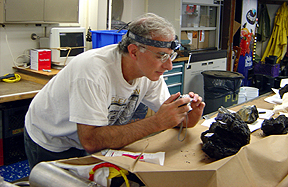
Mike Perfit, a.k.a. Triclops, used a head lamp to shine light on the basalt samples recovered on today's dive as they are photographed for the archive sampled record.